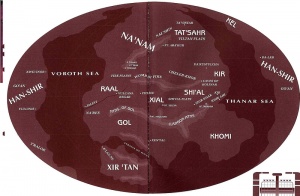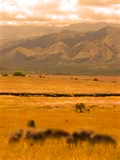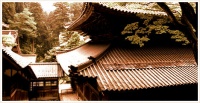More actions
| Line 78: | Line 78: | ||
In the foothills of the [[Arlanga Mountains]] on the edge of the Cheleb-Khor Desert, the Temple of Anonak offered rest and healing to children who endured or were injured in the [[Kahs-wan|kahs-wan]] ritual. Each evening, the monks ventured out to search for the lost and bleeding. Today, search and rescue are still a part of the duties of the priests of Anonak. It continues to be a place of meditation and study open to all. | In the foothills of the [[Arlanga Mountains]] on the edge of the Cheleb-Khor Desert, the Temple of Anonak offered rest and healing to children who endured or were injured in the [[Kahs-wan|kahs-wan]] ritual. Each evening, the monks ventured out to search for the lost and bleeding. Today, search and rescue are still a part of the duties of the priests of Anonak. It continues to be a place of meditation and study open to all. | ||
[[Image:T'Shen.jpg|200px|thumb|left| | [[Image:T'Shen.jpg|200px|thumb|left|T'Shen main complex]] | ||
===T'Shen=== | ===T'Shen=== | ||
Located in the [[Llangon Mountains|Heyalar t’L’langon]] southeast of [[Shi'Kahr]], T'Shen monastery | Located in the [[Llangon Mountains|Heyalar t’L’langon]] southeast of [[Shi'Kahr]], T'Shen monastery is known as one of the few places to traditionally accept outworlders. The order is most famous for teaching the skills of healing trances, biofeedback and neuropressure. | ||
Set in a valley at an elevation of roughly 1000 meters above sea level, the monastery is constructed of the local honey-gold granite and marble, and the wood of the abundantly growing [[Ic'tan|ic'tan]] conifers. The central complex is built in the light, elegant and simplistic style of [[Khomi]]'s 3rd Age, giving credence to the theory that T'Shen might have been founded by healer monks from the neighboring province. The eastern wing overlooks a small mountain lake and shows signs of having been added somewhat later to incorporate baths and storerooms for herbs and medicines. | |||
Several smaller buildings in the vicinity show heavy influence of [[Kir]] architecture, and house long term patients or are used as classromms. | |||
===de’Khriv=== | ===de’Khriv=== | ||
Revision as of 14:31, 18 November 2015

From SHai`aξ'àl'el (anc) - Place-of-rising (sun), morning
Bordered by the Llangon Mountains to the South, Xial to the West, Tat'Sahr to the North and Kir to the East, Shi'Al is a completely landlocked province except for a narrow stretch reaching towards roughly 50km of coastline. This small "buffer" area was ceded from Kir roughly 3000 years ago as part of an alliance, granting the largely trade-oriented Shi'Al clans direct access to the Thanar Sea.
Shi'Al is considered a province of contrasts. With most of its landmass located on or near the equator, it consists of vast areas of desert, among them the famous Forge, but also the larger Cheleb-Kor. The wide stretch of the Llangon Mountains separating Shi'Al from Khomi and Gol is famous for an almost moderate climate and a variety of plant and animal life rivaled only by the T'Ralor preserve. Towards the East, the landscape is mostly scrubland, steppe and a savannah named Yartra Kin-kur, with the latter gradually flowing into the rolling hills of Kir. The Heyalar t’Arlanga separate Southern Shi'Al from the former kingdom of Lhai (today a part of the province). The mountains, while not near as impressive as the Heyalar t’L’langon, still contain many microclimates, and the fertile foothills are dotted with farms. The northernmost region of Shi'Al is mostly flat grassland with a semiarid climate.
One of the most densely populated regions on Vulcan, Shi'Al is considered the planet's cultural center, but its famous capitol Shi'Kahr is far from the only point of interest in this province of variety.
History
An often fractured and much fought for kingdom since antiquity, Shi'Al built much of its ancient wealth on trade, taking full advantage of its location between numerous rivaling clans. Renowned for both political acumen and skill at warfare, the ruling clans weathered millennia of wars and shifting alliances, and many of the planet's oldest families can still be found in this province.
One of the oldest known legends of Vulcan centers around the oasis at Shi'Kahr, then known only as Phelsh't (today's Pelasht), and the conquest of same by a desert-dwelling clan believed to first have evolved with the now common 'inner eyelid' (nictating membrane) that protects Vulcan eyesight from intense light and radiation.
The historical archives of the Science Academy also hold extensive volumes regarding the often tenuous relationship with Lhai and Xial, a strong rivalry of the ruling houses with Kir, which surprisingly rarely erupted into more than border skirmishes, and the by now legendary struggles with the powerful Raal.
F'hauúkh-ar Eξhìkh - The Desert Wars
Historical sources point to border wars with nomadic tribes from Xial dating back to the 35th century (roughly 6500 BCE Federation Standard). The existence of a separate clan inhabiting the forbidding, hostile environment of Sas-a-Shar (today generally referred to as The Forge) is a historical fact, though in earliest sources these Vulcans are often considered little more than myth, or at best uncouth, half-wild barbarians.

With the emergence and growth of settlements all across the province and consolidation of resources by the most powerful clans, the protection of caravanserais, outlying villages and trade routes became a matter of serious concern. While the nomadic tribes saw the villages near or within their borders an encroachment upon their territory, the ruling clans considered the uncivilized desert-dwellers a threat to their wealth and position. Consequently, several forts and strongholds were established across Western Shi'Al, however retaliatory strikes against raiding nomads most often ended in troops returning without ever having caught sight of the enemy.
Leading archaeologists believe the original purpose of the famous T'Karath Sanctuary to have been a fortress to guard against the Sas-a-Shar clan and the Xial nomads, and later a staging point for campaigns against both. Several artifacts and a recently uncovered tomb of a warlord dating back to the 37th century strongly support this notion.
Only marginally significant on a political scale, the F'hauúkh-ar Eξhìkh are the subject of much ancient poetry and prose, and as such considered of cultural importance. The theme of a milennia-long struggle, with nomadic tribes fighting well equipped, superior forces to a standstill over and over is one found on many other worlds; but set in Vulcan's violent splendor the inevitably tragic outcomes have inspired great works of art even from cultures not native to the Vulcan homeworld.
Kir - War and Peace

The relationship between these neighboring provinces has often been described as a living example of the human proverb "Keep your friends close and your enemies closer". While decidedly smaller and with fewer natural resources than Shi'Al, the ancient nation of Kir nonetheless resisted any attempts at conquest. Consequently, many high houses of Shi'Al sought alliances with the two major clans, and through the millennia these extensive entanglements often led to enthusiastic infighting between both Shi'Al and Kir houses over advantageous alliances, or perceived slights.
Until the Age of Expansion most of these skirmishes remained limited to clan feuds, but with advances in weapons technology and many Shi'Al houses attempting to widen their sphere of influence - as well as laying claim to resources needed to hold the powerful rival Raal at bay - several attempts to annex Kir's fertile regions and trading centers erupted into open warfare.
Surprised at the ferocity of the often deemed decadent and unorganized Kir clans, the major clans once more agreed on a settlement with their Eastern neighbors, one of them eventually securing an alliance with one of the high houses which gave them not only access to the Thanar Sea but favored trade status.
While smaller skirmishes should continue until the time of Surak, the alliances held through many upheavals and are part of the reason why none of the most devastating later wars touched Eastern Shi'Al or Kir.
The Rivals of Na'Nam
Separated by the desert-province of Xial, the ruling clans of Raal and Shi'Al had only sporadic - and mostly firnedly - interaction throughout antiquity, when the immediate threat was your neighbor who competed with you for water and food, but the stranger from afar was greeted with interest. This should change however with the rise of Shi'Al to a trade power in its own right, and the advent of technology.
Most of the larger - and most devastating - engagements occurred during the Age of Expansion, but historical sources as well as literature and art date the by now legendary power struggle to have begun millennia earlier. By virtue of alliances with Kir and betimes Khomi, exceptional skill at economic warfare, and not least of all the 'buffer' provided by Xial, the high houses managed to hold their own against the larger, powerful rival, albeit often at great cost.
Perhaps the only thing that prevented the major clans of the two provinces from mutual annihilation was the common threat of Tat'Sahr, the third major power on the continent, and the Vulcan propensity for spreading their warfare in a democratic manner - meaning, there was so much of it that focusing on but one rival at a time was the fastest way to have a third party take cheerful advantage.
Places of Note
Shi'Kahr
One of Vulcan's oldest inhabited settlements, current capital of Shi'Al and legislative capital of Vulcan. Located near the edge of The Forge, and in sight of the Llangon Mountains and Mount Tar'Hana. Towards the east, the desert and scrubland merge into the Yartra Kin-kur.

Cheleb-Kor
A large desert named after Ket-cheleb, the ancient god of anger. Located just north of the Heyalar t'Arlanga, it is famous for its red volcanic sands and bizarre lava formations.
Despite the harsh conditions, Cheleb-Kor and its surrounding regions sustains many animals, including vra'alen, tsh'in, shatarr and the rare lanka-gar. Drought-adapted shrubs in the desert include kala, rishtik and alem-vedik, and the northern regions contain vast stretches of dun-yar grass.
The southwestern portion contains tin, zinc, copper and gold deposits and was mined extensively throughout history. Cheleb-Kor gems mined in the foothills of Arlanga have been prized across the planet, with the most famous being the rubies and garnets.
Once completely within the borders of the Lhai nation, Cheleb-Kor is believed to have been the location of Surak's kahs-wan.
Tauklar t’Kulvir
The old lava tubes of a now inactive volcano, known as The Caves of Kulvir, were once used to tunnel foot and pack-animal traffic from the old capital of Lhai de’Khriv to the Temple of Anonak and the desert beyond. Today the intriguing rock formations and the ruins of an ancient temple destroyed by lava make the caves a popular tourist destination for day-hikers.
Anonak
In the foothills of the Arlanga Mountains on the edge of the Cheleb-Khor Desert, the Temple of Anonak offered rest and healing to children who endured or were injured in the kahs-wan ritual. Each evening, the monks ventured out to search for the lost and bleeding. Today, search and rescue are still a part of the duties of the priests of Anonak. It continues to be a place of meditation and study open to all.

T'Shen
Located in the Heyalar t’L’langon southeast of Shi'Kahr, T'Shen monastery is known as one of the few places to traditionally accept outworlders. The order is most famous for teaching the skills of healing trances, biofeedback and neuropressure.
Set in a valley at an elevation of roughly 1000 meters above sea level, the monastery is constructed of the local honey-gold granite and marble, and the wood of the abundantly growing ic'tan conifers. The central complex is built in the light, elegant and simplistic style of Khomi's 3rd Age, giving credence to the theory that T'Shen might have been founded by healer monks from the neighboring province. The eastern wing overlooks a small mountain lake and shows signs of having been added somewhat later to incorporate baths and storerooms for herbs and medicines.
Several smaller buildings in the vicinity show heavy influence of Kir architecture, and house long term patients or are used as classromms.
de’Khriv
Presently located in central Shi'Al province, de’Khriv was formerly the capital of the Lhai nation but is best known as the home of Surak and possibly his birth place. Surak worked for a time as an accountant in his father’s firm located in the city. Today the city is the second largest population center of Shi'Al, overlooking the fertile Valley of Tsai`Kal. The botanical gardens of de’Khriv house the largest variety of favinit orchids on the planet, and many IT and high-tech companies manitain headquerters in the city.
